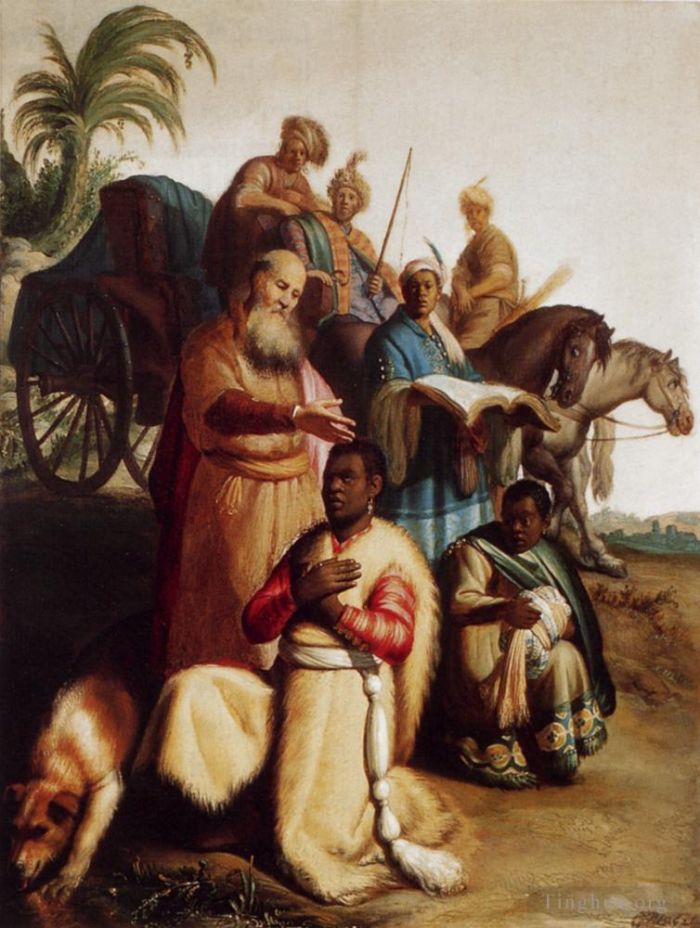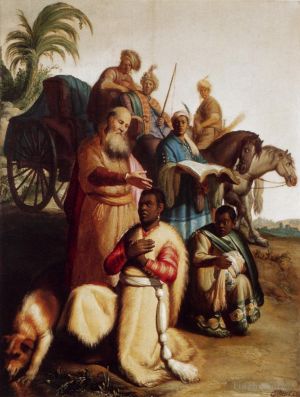The Baptism Of The Eunuch
Rembrandt
- Price: Price on Request
- Art Type: Oil Painting
- Size:
- English Comments: 0
- International Comments: 0
- Creating Date:
- Introduction and Works of Rembrandt >>
Work Overview
- The Baptism of the Eunuch
Artist Rembrandt
Year 1626
Medium Oil on panel
Dimensions 64 cm × 47.5 cm (25 in × 18.7 in)
Style Baroque
Genre genre painting
Location Museum Catharijneconvent, Utrecht
The Baptism of the Eunuch is a 1626 painting by the Dutch artist Rembrandt van Rijn, owned by the Museum Catharijneconvent in Utrecht since 1976. It shows Philip the Evangelist baptising an Ethiopian man, a eunuch, on the road from Jerusalem to Gaza, traditionally marking the start of the Ethiopian Church (Acts 8:26-39).
This painting is not included in the Bredius catalogue.
Rembrandt went to Amsterdam in 1624 to develop his artistic skills in the workshop of Pieter Lastman. Lastman, a Catholic, had spent some time in Italy and gave a course on the treatment of biblical and mythological subjects which opened up new horizons for Rembrandt. He learnt how to arrange multi-figure compositions, and how to evoke historical place and time through he use of lavish, colourful costumes. Lastman also inspired Rembrandt's painting of The Baptism of the Eunuch, a subject favoured by both Catholics and Protestants.
The black man is the chamberlain of the Candace, the queen of Ethiopia. He is a eunuch, because only castrated men were allowed in the queen's inner circle.
After a visit to Jerusalem he meets the apostle Philip. The chamberlain asks him to explain a verse from Isaiah he had just read (53:7) to him. Philip explains the verse and then joins him on his trip. The apostle starts preaching Jesus' gospel to the chamberlain.
Later on, when they reach a river, the chamberlain asks Philip to baptise him. He undergoes the baptism in ecstasy, with his hand on his chest and his eyes directed to heaven.
This is a panel Rembrandt made in the first years of his long career. It is inspired by a painting his teacher Pieter Lastman made in 1623. The panel is signed "RH 1626" in the bottom right. It was rediscovered in 1976 in a private collection.
Image credits: Museum Catharijneconvent, Utrecht, photo Ruben de Heer.
- Copyright Statement:
All the reproduction of any forms about this work unauthorized by Singing Palette including images, texts and so on will be deemed to be violating the Copyright Laws.
To cite this webpage, please link back here.
- >> English Comments
- >> Chinese Comments
- >> French Comments
- >> German Comments
- >>Report
- Bathsheba at Her Bath
- The Return of the Prodigal Son
- Balaam and the Ass
- Stormy Landscape
- Christ driving the moneychangers from the temple 1626
- Young Man At His Desk
- Haesje
- St Paul at his WritingDesk
- The Abduction Of Ganymede
- Self Portrait at an Early Age 1628
- Woman in bed
- History Painting
- David and Uriah
- The Blinding of Samson
- Susanna
- Portrait Of Joris De Caullery
- Portrait of Nicolaes Ruts
- Flora
- Christ In The Storm On The Sea Of Galilee
- The beheading of john the baptist
- The Toilet of Bathsheba
- Susanna and the Elders
- Saskia in Pompous Dress
- Anna and the Blind Tobit
- Samson And Delilah
- Saskia Laughing
- Cupid Blowing Soap Bubbles
- Dead peacocks
- Self Portrait 1659
- The Holy Family with Angels
- The Artists Son Titus
- The denial of peter 1660
- The Baptism Of The Eunuch
- Repentant Judas Returning The Pieces Of Silver
- Portrait of the Artist at His Easel 1660
- Self Portrait as a Young Man 1634
- Young Woman Trying Earrings
- The Stoning Of St Stephen 1625
- Portrait Of An Eighty Three Year Old Woman
- Christ and the Woman Taken in Adultery
- Self-portrait as the Apostle Paul
- Musical Allegory
- The Artist In His Studio
- Maria Trip
- Man In Oriental Dress
- Titus at his desk
- Self portrait 1628
- The Polish Rider
- Agatha Bas
- Adoration of the Shepherds
- Young Man
- The Mennonite Minister Cornelis Claesz Anslo in Conversation with his Wife Aaltje
- Frederick Rihel on Horseback
- David Playing The Harp To Saul
- Portrait of Maria Trip 1639
- Portrait Of Amalia Van Solms
- Portrait Of A Young Woman With A Fan
- The holy family night
- The Elevation Of The Cross
- Jan Rijcksen And His Wife
- Holy Family
- Abraham of Isaac (The Angel Stopping Abraham from Sacrificing Isaac)
- The Mill
- The Risen Christ Appearing to Mary Magdalen
- The Ascension Of Christ
- Portrait of Saskia van Uylenburgh
- Self Portrait 1658
- Elder
- Portrait of Haesje van Cleyburgh
- Saul and David
- Landscape with the Rest on the Flight into Egypt
- The Conspiration of the Bataves
- Self portrait Det
- Portrait Of A Man
- The Holy Family
- Self
- Christ and St Mary Magdalene at the Tomb
- Joseph Accused by Potiphars Wife
- Artemisia
- Supper at Emmaus
- Christ Driving The Money Changers From The Temple
- The Prodigal Son in the Brothel (Rembrandt and Saskia in the Scene of the Prodigal Son in the Tavern)
- Sampling Officials of the DrapersGuild
- Danaë
- Winter Landscape
- Johannes
- JohDet
- Dr Ephraim Bueno Jewish Physician and Writer
- Saskia
- Self Portrait 1660
- Titus van Rijn in a Monks Habit
- Apostle Paul
- Samson at the Wedding
- St John The Baptist Preaching
- Portrait of Maria Trip
- The Night Watch
- Descent from the Cross
- Self Portrait 1669
- Portrait of Saskia with a Flower
- The Prophetess Anna known ass Mother
- The Man with the Golden Helmet
- David and Jonathan
- The Archangel Leaving the Family of Tobias
- Rape of Proserpina
- Portrait Of Maerten Soolmans
- Jeremiah Lamenting the Destruction of Jerusalem
- The Jewish Bride
- Christ on the cross 1631
- The Stone Bridge 1638
- Diana Bathing With The Stories Of Actaeon And Callisto
- Philosopher Reading
- Portrait Of A Woman
- The Anatomy Lesson of Dr Nicolaes Tulp
- Tobit and Anna with the Kid
- Peter Denouncing Christ
- Girl at a Window (Girl Leaning on a Stone Window Sill)
- The Raising of Lazarus
- Saskia Wearing A Veil
- Saskia As Flora
- The Visitation
- The Parable of the Rich Fool (The Rich Man from the Parable)
- Family Group
- Joseph Dream in the Stable in Bethlehem
- The Holy Family with a Curtain
- Deposition from the Cross
- Portrait Of An Old Man
- Self Portrait In A Gorget
- Portrait Of Alijdt Adriaensdr
- Slaughtered Ox (Flayed Ox or Side of Beef or Carcass of Beef)
- Portrait of Nicolaas van Bambeeck
- Portrait Of The Artist In A Flat Cap
- Philosopher in Meditation
- Self Portrait In A Plumed Hat
- The Incredulity of St Thomas
- Self Portrait 1629
- Self Portrait as the Apostle St Paul
- Two Old Men Disputing
- Aristotle with a Bust of Homer
- Belshazzars Feast
- Hendrickje Bathing in a River
- Portrait Of Maria Bockenolle
- Jacob
- Landscape with a Castle
- Portrait of Johannes Wtenbogaert
- Evangelist Matthew
- Self portrait 1632
- Portrait of a bearded man
- Self portrait 1640
- Jacob Blessing the Children of Joseph
- Portrait of a man in military costume
- The Dream of St Joseph
- Hendrickje Slapend RJM
- Portrait of Willem Bartholsz Ruyter
- In Velvet Cap and Plume SIL
- The Sense Of Sight
- Abraham Entertaining the Angels SIL
- Portrait of Willem Bartholsz Ruyter RJM
- Self Portrait 16289
- Sakia Asleep In Bed
- Study from the Nude Man Seated before a Curtain SIL
- The Blindness of Tobit SIL
- Drawing at a window
- Portrait Of Cornelis Claesz 1640
- Saskia In A Straw Hat
- Self Portrait Staring
- The Artists Father
- Ephraim Bonus Jewish Physician SIL









 Singing Palette
Singing Palette